By Commander Neil Westphalen, Royal Australian Navy
This paper was first published in the Journal of Military and Veterans’ Health, Volume 27 Number 2 in April 2019. Commander Westphalen is a member of the Society and Active Reserve. He served as the in Fleet Medical Officer from 2013 to 2016. Additional biographical details are at the end of this paper.
Purpose
Mariners have been identifiable by their clothing for centuries. This reflects their ongoing need for attire that allows free movement for negotiating ladders, doorways and hatches, and performing physically demanding tasks such as hauling lines on cluttered decks and moving heavy weights. In the past, their garments also had to permit climbing masts and yards, and manning windlasses and capstans. More recent requirements include facilitating fighting fires, floods and toxic hazards, and preventing vector-borne disease. All these tasks have been performed in climates ranging from tropical to polar, in winds up to 300 km/h, and despite sea states ranging from flat calm to ‘phenomenal’.[1]
More than a century after its establishment, many Royal Australian Navy (RAN) uniforms and ranks still reflect those used by the (British) Royal Navy (RN). This first of a three-part article describes the history of Navy sailor uniforms or ‘rigs’ since 1509. The second explains the development of male and female Navy health sailor uniforms since 1879, while the third describes the evolution of Navy medical and dental sailor rank and rate badges since 1827.
Subsequent articles will do likewise for RAN health officers.
Background
During the five centuries after the 1066 Norman conquest,[2] English maritime power was mostly limited to the North Sea and English Channel. It was used for trade with northern Europe, transporting armies and providing their logistic support, countering (and sometimes engaging in) piracy, and defence against the French after most of the English-ruled territory within France was lost in 1453.[3]
Even so, it was not until 1509 that Henry VIII founded the Royal Navy in its current form, as a force of state-owned dedicated warships with their own shore-based infrastructure. Until then, the term ‘navy’ referred to ships of all sizes and types throughout the realm, whether they were owned by the monarch (if he had any), or his merchant subjects. The monarch would hire his ships out to the merchants for trade, and could ‘arrest’ their ships and crews for his own purposes when required. The same ships were therefore used for both warlike and peacetime purposes.[4]
Furthermore, there were no dedicated English shipyards until the early 15th century. Rather, ships were built and maintained anywhere where temporary iron foundries could be built, with access to deep water and suitable timber supplies. Although a Clerk of the King’s Ships provided administrative support for all royal and ‘arrested’ ships, this only entailed managing the finances.[5]
Consequently, medieval and early Reformation English mariners were employed interchangeably between their monarch and private merchants. They performed their duties in accordance with the Laws (also Rules or Rolls) of Oléron[6] and the Black Book of the Admiralty,[7] which applied to all English ships irrespective of who owned them.
Sailor Uniforms
The Laws of Oléron and the Black Book of the Admiralty did not require shipmasters to provide clothing for their crews. They also gave mariners the right to choose their captain, which endured until the 1870s.[8]
Although these conditions of service mattered little while voyages lasted for only a few days, they became problematic after 1415, when Prince Henry the Navigator of Portugal[9] began sponsoring a series of long-duration voyages along the West African coast. The ensuring Age of Exploration led to voyages by Bartholomew Diaz to the Cape of Good Hope in 1487-88,[10] Vasco da Gama to India in 1497-99,[11] Christopher Columbus to America in 1492-1504,[12]and Ferdinand Magellan’s world circumnavigation in 1519-22.[13]
England followed suit from the 1490s, with voyages to North America by John Cabot[14] and his son Sebastian,[15] to Russia by Sir Hugh Willoughby,[16] and to West Africa and the Americas by luminaries including John Hawkins[17]Francis Drake[18], Martin Frobisher,[19] and Walter Raleigh.[20]
Many of these voyages led to the near or total annihilation of their crews, often from a range of shipboard medical conditions.[21] These included cold injuries such as frostbite, hypothermia and non-freezing cold injuries caused by inadequate clothing,[22] and typhus[23] caused by the crews bringing fleas and lice on board via their apparel.[24] Yet the latter danger was first documented by English physician Gilbertus Anglicus, whose Compendium Medicinae(written between 1230 and 1250), noted that ‘frequent changes of clothing will palliate the annoyance of fleas and pediculi’ when at sea.[25]
Henry VIII had approved a uniform for men from the Cinque Ports prior to his death in 1547, albeit more for ceremonial than hygiene purposes.[26] In 1595, Richard Hawkins was one of very few commanders who provided clothing for his ship’s company,[27] while other ship’s companies were issued with Arctic attire in 1602.[28] Otherwise, clothing for Elizabethan and early Stuart sailors was only provided on an ad hoc basis, by the occasional Admiralty official as a for-profit personal peculation.[29]
While successful in preventing a Spanish invasion, England’s Armada campaign from July to September 1588 ended with multiple logistic shortfalls. These included clothing, resulting in high rates of illness and death. The fleet commander, Lord Howard of Effingham, wrote (to no avail):
‘My Lords, I would think it a marvellous good way that there were a thousand pounds’ worth… of hose, doublet, shirts, shoes and such like sent down… for else in very short time I look to see most of the mariners go naked’.[30]
Thirty years later, English operations in the Mediterranean against Algerian corsairs in 1620-21,[31] the 1625 attack on Cadiz,[32] and the operations against the French at La Rochelle in 1627-28[33] all failed, largely because of disease outbreaks. In 1627 Sir Henry Mervyn, Admiral of the Narrow Seas, wrote:
‘The more than miserable condition of the men, who have neither shoes, stockings, nor rags to cover their nakedness… all the ships are so infectious that I fear if we hold the sea one month we shall not bring men enough home to moor the ships.’[34]
Although ‘slop’ clothing was made available from that year,[35] its effectiveness as a preventive hygiene measure was generally negated by financial considerations. The ongoing occupational mobility between private merchantmen and the King’s ships meant that entrants joining the latter were ineligible for new clothing during their first month aboard.[36] This was extended to two months in 1663, but was cancelled a year later because of its adverse health effects.[37]
Even then, sailors had the cost of their slops deducted from their wages on discharge from their ship.[38] The clothing provided was also poor quality yet expensive: in 1628 seamen were paid 15 shillings a month,[39] while one full suit officially cost 1 pound 7 shillings (nearly two months’ wages),[40] plus a 10% commission to the supplier, and 5% each to the paymaster and the purser. These expenses did not include various unofficial and often illicit charges.[41]
Furthermore, the provision of slop clothing from multiple suppliers meant it was not standardised. By comparison, the first British Army uniforms were introduced with the return of King Charles II to the throne in 1660,[42] and for Navy officers in 1748.[43]
The itinerant nature of British sailors’ employment meant this situation remained extant for nearly 250 years. Yet in 1704, Surgeon Patrick Campbell was the first of a succession of Navy medical officers who, among a range of other hygiene improvements, recommended the free issue of uniforms.[44]
Meanwhile high levels of shipboard morbidity and mortality continued. This culminated in the loss of 1300 out of 2000 men during Commodore George Anson’s circumnavigation in 1740-44, only four of whom were killed in action. While this deployment had one of the worst death rates from scurvy ever recorded, typhus and cold injuries caused by inadequate clothing also played their part.[45]
However, in 1757 the Admiralty approved a uniform for hospital patients ashore, albeit less of a hygiene measure than to prevent desertion. In 1781, it also introduced harbour-based ‘slop ships’ to receive new entrants, who were issued new clothing prior to joining their ship. A major hygiene initiative saw soap being issued from 1796, although in 1815 the quantities were still considered inadequate.[46]
The century following Anson’s voyage also saw the gradual evolution of approved patterns for winter and summer attire, which began to resemble the present junior sailors’ ‘square rig’ dress uniforms from the 1830s. However, this did not prevent aberrations: in the 1830s the Captain of HMS Blazer dressed his boat’s crew in striped jackets, while as late as 1853, Captain Wilmott of HMS Harlequin paid for his boat’s crew to be dressed as harlequins.[47]
Even before the 1853-56 Crimean War, the Royal Navy had a manning crisis, caused by a lack of volunteers, the end of forced recruitment (press gangs) at the end of the Napoleonic Wars in 1815, and in particular, the inability to retain sailors between the end of their ships’ commission and the beginning of the next.[48] There was no trained reserve to get additional ships to sea, while the lack of a shore-based recruiting organisation meant captains still had to find their own crews.[49] For example, in 1857 the new battleship HMS Renown required 860 men,[50] yet despite waiting 172 days she still sailed 62 men (7%) short.[51]
Among other responses, continuous service with ten-year engagements was introduced in 1853.[52] Although it did not completely displace non-continuous service until the 1870s,[53] this initiative finally overcame the financial objections to free uniforms from 1857. These took two forms: one had a short open-front ‘bluejacket’ (not very dissimilar to the current ‘battledress’ jacket, apart from the latter’s pockets), the other with a loose ‘frock’ jumper-like top that tucked into the trousers.[54] In 1890 the ‘bluejacket’ was abolished, while the ‘frock’ top was replaced by a tight-fitting jumper worn outside the trousers, which became the current dress uniform worn by RAN junior sailors.[55]
These uniforms generally reflected the seagoing workplace requirements of the time. They lacked pockets, to prevent men from carrying objects that could fall out when working aloft. For the same reason, clasp knives for cutting lines in an emergency were secured with lanyards, as were bosun’s calls (pipes) used for signalling orders though the ship.
Contrary to popular belief, blue jean collars were not worn to protect sailor’s clothing from the tar used for their pigtails during the Napoleonic Wars. Rather, they were introduced in the 1830s for ornamental purposes, after pigtails were no longer worn. The collars initially had a rounded edge similar to contemporary fashion ashore but were later cut square, so seamen could make their own more easily. The three white collar stripes likewise do not represent Nelson’s victories over the French, but are simply decorative.[56]
Bell-bottom trousers or ‘bells’ allowed rolling the legs up for swabbing decks and working aloft. Rather than a button-up fly, they had a wide ‘piss flap’ at the front that buttoned up the trouser sides. In order to make best use of limited messdeck storage space, the trousers were turned inside out and folded vertically at hands-breadth intervals, and taped into a rectangular block. The number of folds do not represent the seven seas but vary from five or more, depending on the wearer’s height. [57]
Sailor caps lacked peaks, to enable looking up when working aloft and for watching the wind on the sails when steering the ship. Wide-brimmed ‘sennet’ straw hats were worn in the tropics for sun protection until 1921. Officer and sailor caps both had blue and white covers for winter and summer wear, with the latter being used all year round from 1953.[58]
Sailors often painted the name of their ship on their caps from the late 18th century until the introduction of ‘cap tally’ ribbons in 1857. For security reasons, ship names were omitted during both World Wars, leaving only ‘HMS’ (or ‘HMAS’ for Australian personnel).[59]
Although boots were worn ashore, most men at sea went barefoot until sometime before the First World War.
Double-breasted jackets, ties and peaked caps, which became known as ‘fore-and-aft rig’, were introduced for all Chief Petty Officers in 1879,[60] and were extended to all ‘civil branch’ (non-seaman) junior sailors in 1890.[61] ‘Fore-and-aft’ rigs will be described in Parts Two and Three of this article.
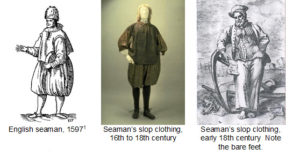
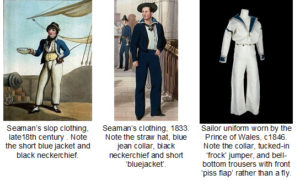
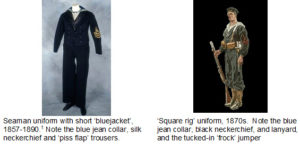
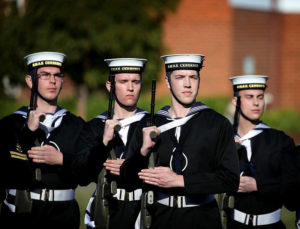
Recruit graduation parade, HMAS Cerberus, 2017[64] Note the blue jean collar, black neckerchief, lanyard, and the jumper outside the trousers.
RAN Sailor Uniforms
The uniforms for the Australian colonial naval forces from 1865 to 1901, the Australian Commonwealth Naval Forces from 1901 to 1911, and the RAN from 1911 to 1966, were all generally similar to their RN counterparts. RAN sailors in particular were distinguished only by RAN-specific buttons, and the ‘HMAS’ on their cap tally ribbons.[65] Bell-bottom trousers were worn in the RAN until the 1990s.
The use of the current dress uniform in combat was modified during the First World War, by adding anti-flash hoods and gloves to protect personnel from burning cordite,[66] and anti-gas respirators in response to the use of chemical weapons on the Western Front.[67]
Khaki uniforms for Navy personnel were first worn ashore by the Victorian and NSW contingents to the Boxer Rebellion in China in 1900-01. They were reintroduced for RAN officers at the end of 1942, and for RAN sailors two months later, to prevent vector-borne disease.[68] This became the blue Action Working Dress for all male RAN personnel from 1948.[69]
Action Working Dress was replaced for both male and female personnel by one-piece grey overalls from 1992. These had ‘Proban®’ anti-flash fire protection treatment, in response to high rates of burn injuries during the 1982 Falklands War.[70] The Proban® ‘’ralls’ also had reflective tape on the upper arms, to improve the ability to see ‘man overboard’ victims.[71]
‘Probans’ were replaced by the current two-piece Disruptive Pattern Naval Uniform (DPNU) from 2009. These used the same ‘stealth bunny rabbit’ camouflage pattern as the contemporary Army field uniform, albeit in grey, blue and green colours consistent with the maritime environment.



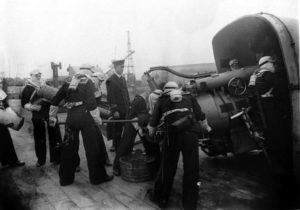
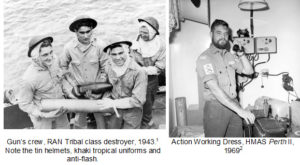
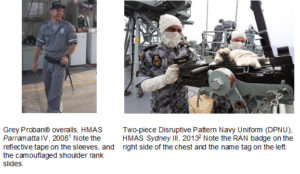
Conclusion
Despite a history extending over more than 500 years, RN sailors had no standard uniform until the 1850s. For much of this period, high levels of preventable deaths were frequently cased by sailors bringing typhus-carrying fleas and lice on board, while other deaths resulted from cold injuries caused by inadequate clothing. Despite the frequently disastrous impact on operational capability, this continued to occur for predominantly financial reasons, which were only resolved by addressing personnel conditions of service.
Notwithstanding the vast enhancements to shipboard and personal hygiene since, the requirement to ensure access to suitable apparel to protect RAN members from shipboard hazards and vector-borne disease remains extant. This is particularly relevant for personnel engaged in littoral and other maritime operations in southeast Asia, the southwest Pacific and the southern Indian Ocean.
Author
Dr Neil Westphalen graduated from Adelaide University in 1985 and joined the RAN in 1987. He is a RAN Staff Course graduate and a Fellow of the Royal Australian College of General Practitioners, the Australasian Faculty of Occupational and Environmental Medicine, and the Australasian College of Aerospace Medicine. He also holds a Diploma of Aviation Medicine and a Master of Public Health.
His seagoing service includes HMA Ships Swan, Stalwart, Success, Sydney, Perth and Choules. Deployments include DAMASK VII, RIMPAC 96, TANAGER, RELEX II, GEMSBOK, TALISMAN SABRE 07, RENDERSAFE 14, SEA RAIDER 15, KAKADU 16 and SEA HORIZON 17. His service ashore includes clinical roles at Cerberus, Penguin, Kuttabul, Albatross and Stirling, and staff positions as J07 (Director Health) at the then HQAST, Director Navy Occupational and Environmental Health, Director of Navy Health, Joint Health Command SO1 MEC Advisory and Review Services, and Fleet Medical Officer (2013–2016).
Commander Westphalen transferred to the Active Reserve in 2016.
Acknowledgements
The author would like to thank Mr John Perryman, CSM (Director Strategic and Historical Studies), Mrs Debra Locke (Deputy Director Navy Uniforms), CMDR Phil Davies RAN (Rtd) and LCDR David John RANR (Rtd), for their assistance with this article.
Disclaimer
The views expressed in this article are the author’s, and do not necessarily reflect those of the RAN, or any of the other organisations mentioned.
[1] In this instance, the term ‘phenomenal’ refers to waves over 14 metres high. See WOCE Upper Ocean Thermal Data, available from https://www.nodc.noaa.gov/woce/woce_v3/wocedata_1/woce-uot/document/wmocode.htm
[2] For a popular history of the Norman Conquest and its aftermath, see Schama, S. 2000 A History of Britain: at the edge of the world 3000BC – AD1603 BBC Worldwide: London pp 66-113
[3] See Rose, R. 2013 England’s Medieval Navy 1066-1509: Ships, Men and Warfare Seaforth Publishing: Barnsley UK
[4] See Rose, R. 2013 England’s Medieval Navy 1066-1509: Ships, Men and Warfare Seaforth Publishing: Barnsley UK
[5] See Rose, R. 2013 England’s Medieval Navy 1066-1509: Ships, Men and Warfare Seaforth Publishing: Barnsley UK
[6] The Rules of Oleron (circa 1266), available from http://www.admiraltylawguide.com/documents/oleron.html
[7] See Twiss, T (ed). 1871-1876 The Black Book of the Admiralty Volumes 1-4 The Lawbook Exchange: New Jersey
[8] Baynham, H. 1971 Before the Mast: Naval Ratings of the 19th Century, Hutchinson: London p 14
[9] Henry the Navigator, available from https://www.britannica.com/biography/Henry-the-Navigator
[10] Bartholomew Diaz, available from https://www.britannica.com/biography/Bartolomeu-Dias
[11] Vasco da Gama; available at https://www.britannica.com/biography/Vasco-da-Gama
[12] Christopher Columbus; available at https://www.britannica.com/biography/Christopher-Columbus
[13] Ferdinand Magellan; available at https://www.britannica.com/biography/Ferdinand-Magellan
[14] John Cabot, available from https://www.britannica.com/biography/John-Cabot
[15] Sebastian Cabot, available from https://www.britannica.com/biography/Sebastian-Cabot-British-navigator
[16] Hugh Willoughby; available at https://www.britannica.com/biography/Hugh-Willoughby
[17] Sir John Hawkins; available at https://www.britannica.com/biography/John-Hawkins-English-naval-commander
[18] Sir Francis Drake; available at https://www.britannica.com/biography/Francis-Drake
[19] Sir Martin Frobisher; available at https://www.britannica.com/biography/Martin-Frobisher
[20] Sir Walter Raleigh; available at https://www.britannica.com/biography/Walter-Raleigh-English-explorer
[21] For instance, in May 1553 Sir Hugh Willoughby left London in three ships, in an attempt to reach China via the Northeast Passage. One ship returned having wintered near Archangelsk in northern Russia, while the other two with 63 men were found anchored at the mouth of the River Varzina (east of Murmansk) by fishermen the following summer, with no survivors. See Gordon, EC, The Fate of Sir Hugh Willoughby and His Companions: A New Conjecture. The Geographical Journal, Vol 152 No 2, pp 243-7, available from http://www.jstor.org/stable/634766
[22] For an overview of cold injuries, see Tipton, MJ, Chapter 4 – Non-Freezing Cold Injuries, available from https://www.researchgate.net/profile/Mike_Tipton/publication/237712021_Chapter_4_-_Non-Freezing_Cold_Injuries/links/02e7e52f2a0ae99c22000000/Chapter-4-Non-Freezing-Cold-Injuries.pdf; Biem J, Niels Koehncke N, Classen, D, James Dosman, J, Out of the cold: management of hypothermia and frostbite, available from http://www.cmaj.ca/content/168/3/305.short
[23] See Centres for Disease Control and Prevention, ‘Epidemic Typhus’, available from https://www.cdc.gov/typhus/epidemic/index.html
[24] See Keevil, JJ. 1957 Medicine and the Navy Volume 1 (1200-1649) E&S Livingstone: London p 174
[25] The Project Gutenberg eBook, Gilbertus Anglicus, by Henry Ebenezer Handerson, available from: https://www.gutenberg.org/files/16155/16155-h/16155-h.htm
[26] The Cinque Ports rendered ship service to the English Crown in return for a range of taxation and other privileges, from the late Saxon or early Norman times until the 1588 Spanish Armada. See The Cinque Ports, available from http://cinqueports.org
[27] Oppenheim, M. 1896 A History of the Administration of the Royal Navy and of Merchant Shipping in Relation to the Navy: from MDIX TO MDCLX; With an Introduction Treating of the Preceding Period The Bodley Head: London p 134
[28] Manwaring, GE. The Dress of the British Seaman II; Mariner’s Mirror, 9:6, pp 163-164, available from http://www.tandfonline.com/doi/pdf/10.1080/00253359.1923.10655206
[29] Oppenheim, M. 1896 A History of the Administration of the Royal Navy and of Merchant Shipping in Relation to the Navy: from MDIX TO MDCLX; With an Introduction Treating of the Preceding Period The Bodley Head: London p 138
[30] Quoted in Hanson, N. 2003 The Confident Hope of a Miracle: The True Story of the Spanish Armada, Corgi Books: London, p 535
[31] See Rodger, NAM. 1997 The Safeguard of the Sea: A Naval History of Britain 660-1649 WW Norton & Company, New York pp 352-3
[32] See Rodger, NAM. 1997 The Safeguard of the Sea: A Naval History of Britain 660-1649 WW Norton & Company, New York pp 358-9
[33] See Rodger, NAM. 1997 The Safeguard of the Sea: A Naval History of Britain 660-1649 WW Norton & Company, New York pp 360-1
[34] Oppenheim, M. 1896 A History of the Administration of the Royal Navy and of Merchant Shipping in Relation to the Navy: from MDIX TO MDCLX; With an Introduction Treating of the Preceding Period The Bodley Head: London p226
[35] The term ‘slops’ first described short, baggy trousers, worn by men, especially sailors, in the 16th and 17th centuries. See ‘slop2’ available at http://www.dictionary.com/browse/slop
[36] Manwaring, GE. The Dress of the British Seaman II; Mariner’s Mirror, vol 9 no 6, p 168, available from http://www.tandfonline.com/doi/pdf/10.1080/00253359.1923.10655206
[37] Keevil, JJ. 1958 Medicine and the Navy Volume 2 (1649-1714) E&S Livingstone: London p 90
[38] Manwaring, GE. The Dress of the British Seaman II; Mariner’s Mirror, vol 9 no 6, p 168, available from http://www.tandfonline.com/doi/pdf/10.1080/00253359.1923.10655206
[39] Oppenheim, M. 1896 A History of the Administration of the Royal Navy and of Merchant Shipping in Relation to the Navy: from MDIX TO MDCLX; With an Introduction Treating of the Preceding Period The Bodley Head: London p 138
[40] One pound (£) = 20 shillings (s) = 240 pence (d). £1 in 1628 would equal £247.90 in 2016, or AU$438.78 at AU$1.77 per £ as of November 2017. See Inflation Calculator, available from http://www.bankofengland.co.uk/education/Pages/resources/inflationtools/calculator/default.aspx
[41] Powell, I.G, Seventeenth Century “Profiteering” in the Royal Navy;, available from http://www.tandfonline.com/doi/pdf/10.1080/00253359.1921.10655038
[42] See Tinsey,J. 1994 The British Army 1660-1704, Osprey: Oxford
[43] Manwaring, GE, The First Naval Uniform for Officers: The Story of the Blue and White Costume of 1748. The Mariner’s Mirror, vol 6 no 4, pp 105-114, available from http://www.tandfonline.com/doi/pdf/10.1080/00253359.1920.10654910
[44] Keevil, JJ, 1958 Medicine and the Navy 1200-1900. Vol 2 (1649-1714) E&S Livingstone: London p 245
[45] See Heaps, L. 1973 Log of the Centurion: based on the original papers of Captain Philip Saumarez on board HMS Centurion, Lord Anson’s flagship during his circumnavigation 1740-44, Macmillan: New York
[46] Lloyd, C, Coulter, JLS. 1961 Medicine and the Navy 1200-1900. Vol 3 (1714-1815). E&S Livingstone, London, pp 77-80
[47] The History of Rating’s Uniforms, available from https://web.archive.org/web/20060304101909/http://www.royal-navy.mod.uk/server/show/nav.3772
[48] Baynham, H, 1969 From the Lower Deck: The Old Navy 1780-1840, Hutchison: London
[49] Baynham, H, 1971 Before the Mast: Naval Ratings of the 19th Century, Hutchinson: London
[50] William Loney RN – Background: HMS Renown, available at http://www.pdavis.nl/ShowShip.php?id=55
[51] Baynham, H, 1971 Before the Mast: Naval Ratings of the 19th Century, Hutchinson: London p 120
[52] Wells J, 1994 The Royal Navy: An Illustrated Social History 1870-1982 Allan Sutton Publishing: Phoenix Mill UK, p 10
[53] Baynham, H, 1971 Before the Mast: Naval Ratings of the 19th Century, Hutchinson: London p 120
[54] Coleman, EC, 2011 Rank and Rate Volume II: Insignia of Royal Naval Ratings, WRNS, Royal Marines, QARNNS and Auxiliaries Crowood Press: Ramsbury Marlborough Wiltshire
[55] 1890 Uniform Regulations, available from http://www.pbenyon.plus.com/Uniform/1890_Uniform_Regs.html
[56] The History of Rating Uniforms, available from http://webarchive.nationalarchives.gov.uk/+/http://www.royalnavy.mod.uk/training-and-people/rn-life/uniforms-and-badges-of-rank/the-history-of-rating-uniforms/
[57] The History of Rating Uniforms, available from http://webarchive.nationalarchives.gov.uk/+/http://www.royalnavy.mod.uk/training-and-people/rn-life/uniforms-and-badges-of-rank/the-history-of-rating-uniforms/
[58] Canadian Military Police Virtual Museum ‘Royal Canadian Navy Regulating Branch And Naval Police: Hats and Headwear’, available from http://www.mpmuseum.org/rcnhat.html
[59] The introduction of official navy uniforms, available from http://www.rmg.co.uk/discover/explore/sailors-cap-ribbons
[60] 1879 Uniform Regulations, available from http://www.pbenyon.plus.com/Uniform/1879_Uniform_Regs.html
[61] 1890 Uniform Regulations, available from http://www.pbenyon.plus.com/Uniform/1890_Uniform_Regs.html
[62] Manwaring, GE. The Dress of the British Seaman II; Mariner’s Mirror, vol 9 no 6, p 168, available from http://www.tandfonline.com/doi/pdf/10.1080/00253359.1923.10655206
[63] Royal Naval uniform: pattern 1857, available from http://collections.rmg.co.uk/collections/objects/72795.html
[64] Navy photograph 20170721ran8115969_204, available from http://images.navy.gov.au/fotoweb/archives/5011-Royal%20Australian%20Navy/DefenceImagery/2017/S20171775/20170721ran8115969_204.jpg.info#c=%2Ffotoweb%2Farchives%2F5011-Royal%2520Australian%2520Navy%2F%3Fq%3DLeading%2520Seaman
[65] Commonwealth Forces Naval Orders 1/13, available from http://www.navy.gov.au/sites/default/files/documents/Commonwealth_Naval_Orders_1913.pdf
[66] Cordite was used as a military propellant. Rather than explod ing, it ‘deflagrates’ at sub-sonic speeds, producing very large amounts of hot gas at a rate slow enough to force projectiles from guns without bursting the barrels. See Naval Propellants – A Brief Overview, available from http://www.navweaps.com/index_tech/tech-100.htm.
The British lost one armoured and three battlecruisers to burning cordite at the Battle of Jutland on 31 May 1916, with only 28 survivors out of about 4,200 men. See Hough, R, 1983 The Great War at Sea 1914-1918 Oxford University Press: New York.
[67] See Heller, CE. Chemical Warfare in World War I: The American Experience, 1917 – 1918, Leavenworth Research Paper No 10, Combined Arms Research Laboratory website, available from https://www.webharvest.gov/peth04/20041017045619/http://www.cgsc.army.mil/carl/resources/csi/Heller/HELLER.asp#1
[68] Commonwealth Naval Order 170/43, available from http://www.navy.gov.au/sites/default/files/documents/Commonwealth_Naval_Orders_1943.pdf
[69] Commonwealth Naval Order 66/48, available from http://www.navy.gov.au/sites/default/files/documents/Commonwealth_Naval_Orders_1948.pdf
[70] 34% of all UK shipboard casualties during the Falklands War were burns cases, compared to 14% of UK casualties overall. See McLean, AD, Burns and Military Clothing, J R Army Med Corps 2001; 147: 97-106, available from http://jramc.bmj.com/content/jramc/147/1/97.full.pdf: this reference indicates that,although there is no contemporaneous medical literature, thermoplastic materials such as nylon did not cause any difficulties in the management of military burns.
[71] See Proban® Apparel, available from http://www.guardiansafety.com.au/products/sub-category/proban%C2%AE-apparel
[72] Button, Royal Naval uniform: pattern pre-1891, available from http://collections.rmg.co.uk/collections/objects/77088.html
[73] Button, Royal Naval uniform: pattern 1901, available from http://collections.rmg.co.uk/collections/objects/77149.html
[74] Button, Royal Australian Naval uniform: pattern 1927, available from http://collections.rmg.co.uk/collections/objects/78144.html
[75] Button, Royal Australian Naval uniform: pattern 1936, available from http://collections.rmg.co.uk/collections/objects/78146.html
[76] J2V843 Royal Australian Navy – Ratings 23mm QC Gilt BDFA, available from http://www.kellybadge.co.uk/stock/australianinsignia.htm
[77] Australian War Memorial photograph P04849.001, available from https://www.awm.gov.au/collection/C1117891
[78] Australian War Memorial photograph EN0123, available from https://www.awm.gov.au/collection/C992387
[79] Australian War Memorial photograph EN0167, available from https://www.awm.gov.au/collection/C43672
[80] Australian War Memorial photograph 016471, available from https://www.awm.gov.au/collection/C238358
[81] Australian War Memorial photograph NAVY18922, available from https://www.awm.gov.au/advanced-search?query=HMAS+1975+gun&collection=true&facet_type=Photograph&page=3
[82] Australian War Memorial photograph P11372.039, available from https://www.awm.gov.au/collection/C2076090
[83] Navy photograph 20130619ran8247532_012, available from https://images.navy.gov.au/Home/Search?Query=20130619ran8247532_012.jpg&Type=Filename




